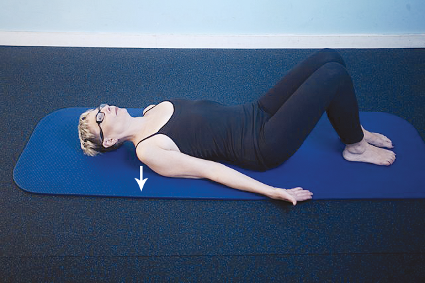Exercising Your Bones: Part 2 of 3 (Alignment)
By Rebekah Rotstein, NCPT
Last month we explored how exercise benefits your bones, noting the importance of consistency, progression, and enjoyment in your routine. We identified the three methods of building bone tissue: weight bearing movement, resistance exercise and impact activities.
But only focusing on these elements overlooks a key component of essential exercise programming for bone health – that of body alignment, and more specifically, joint positioning.
Say you’re used to standing with your ribs pressed forward, thinking that’s how you should present with good posture so that you’re not slouching. This altered placement of the torso changes the muscle activation of your trunk muscles, over recruiting the back and often inhibiting the abdominals, both creating weakness over time and potential back strain. Adding heavier loads from weights to that forced postural presentation can make your body vulnerable to injury.
From a bone health perspective, the beneficial forces from the weights may not transmit evenly through the spine and body in that distorted postural presentation. The better aligned your skeleton is in a standing, weight-bearing position, the better ability to optimize the loading forces from both gravity and external resistance. In other words, body alignment plays a role in bone strengthening.
ALIGNMENT 101
So how can you improve your body alignment? A great place to start is to unload your skeleton. If you have osteoporosis or osteopenia, and more so if you have a history of a fracture, decompress your spine daily by lying on your back with bent knees. This is known as Constructive Rest Position. Focus on your breath here, spending anywhere from several minutes to say 10 minutes a day. Just be sure to provide proper head support if needed to avoid any neck strain.
Next, try the following exercises:
Supine Shoulder Press
-to improve posture and decompress the spine
Lie on your back with knees bent. Inhale with palms face up by your hips. Exhale and gently press your shoulders into the mat for several seconds. Inhale and release, and then exhale and press again. Repeat several times.
Abdominal Press
-for core/trunk stability and spine alignment
Lie on your back with knees bent and inhale. As you exhale, drop your belly as if it’s moving away from the fabric of your pants while you zip them up. This alone will activate your abdominals. For more challenge, lift your legs to a 90 degree angle at the hips and knees. Inhale again, and as you exhale, draw the belly in and up more while you press your hands into your thighs to block them from moving toward your face. Keep the legs in the air and repeat the abdominal press (inhale, exhale and press) up to 10 times.
Back Extension
-for back and spine strengthening
Lie on your belly with your forehead down, hands by your hips, palms face up. *If you’ve had a previous fracture or are concerned about your ribs, you may want to place a thin pillow under your ribs. Gently press your pubic bone into the mat. (Your pubic bone is the bony projection below your belly and above your genitals.) Lift your low belly slightly to activate your abdominal muscles. Float your head and hands off the mat just a few inches, while you continue to look downward. Hold the position 10 seconds before lowering. Repeat up to 10 times.
Standing Rows
-for weight-bearing and resistance and to assist spine alignment
Stand up and tie a resistance band to a doorknob (close and lock the door for safety!) or use a cable machine at the gym. With knees slightly bent, hold the band ends in both hands and inhale. Exhale and pull back from your elbows and shoulders. Slowly release moving your arms forward again as you inhale. Perform 10 times, working up to a total of 3 sets.
What do you experience in your body after performing these exercises? You may sense that your head stacks more easily over your trunk or that your chest feels broader. You probably notice that it takes less effort now to stand tall.
Next month, we’ll explore how posture and alignment relate to balance, which plays a major factor in bone safety. Meanwhile, practice these exercises throughout each week and notice how you feel stronger, more capable, and ready to take the next step in protecting your bones.
Remember, if you have questions about safe movement or if you’re trying something new, always talk to your healthcare provider first.
EXERCISING YOUR BONES SERIEs By Rebekah Rotstein, NCPT
Rebekah Rotstein is an industry leader for Pilates, bone health and movement education. She is the founder of Buff Bones®, a medically-endorsed exercise system for bone and joint health with on-demand classes and trained instructors in more than 30 countries. A former ballet dancer, Rebekah also worked in the Sports Medicine department of Smith College as a student athletic trainer starting in 1994. Her ongoing study of the body includes cadaver dissections along with coursework in fascia research, somatic studies and visceral manipulation. A diagnosis of osteoporosis at age 28 motivated her to advocate for others with low bone mass and to provide them with innovative education and programming. She has presented at numerous conferences in the Pilates industry, at the International Osteoporosis Foundation Worldwide Conference and for the International Association for Dance Medicine and Science. Rebekah is a member of the Ambassador Leadership Council for the Bone Health and Osteoporosis Foundation, an ambassador for American Bone Health and worked as a partner of the U.S. Department of Health and Human Services Office of Women’s Health. She also serves on the Bone Health Working Group for the Society for Women's Health and Research, contributing to the 2021 recommendations published in the Journal for Women’s Health.






